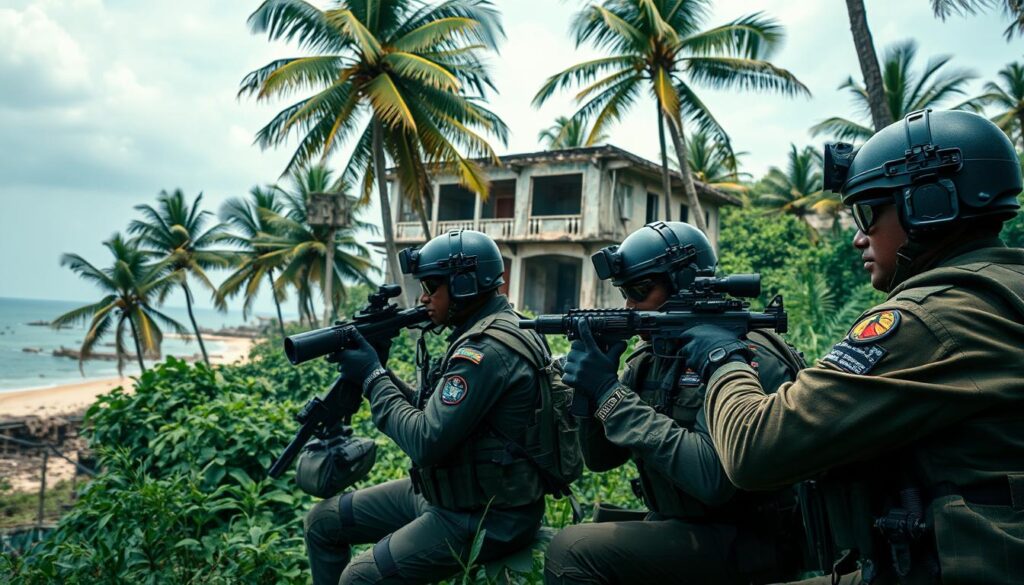Sri Lanka Government Launches Domestic Debt Restructuring Plan
Sri Lanka has unveiled a domestic debt restructuring plan to tackle its economic crisis. The strategy aims to meet IMF bailout conditions and restore stability. The goal is to reduce overall debt to 95% of GDP by 2032.

Sri Lanka is implementing major economic reforms as part of the IMF program. The plan includes a 30% haircut for local dollar-denominated bonds. These bonds will have a six-year maturity at 4% interest.
Bilateral dollar creditors have a different option. They can choose no principal haircut with a 15-year maturity. This option includes a nine-year grace period at 1.5% interest.
The restructuring also covers local currency bonds held by superannuation funds. These will be swapped for longer maturity bonds with 9% interest. CBSL-held Treasury bills will become bonds maturing between 2029-2038.
Sri Lanka’s economy faces severe challenges. The country’s GDP shrank by 7.8% in 2022 and 11.5% in Q1 2023. Real wages fell by 30-50% in 2022. Nearly 43% of children under five suffer from malnutrition.
The government aims to finalize debt restructuring talks by September. This aligns with the first review of its IMF program. The goal is to address pressing issues and pave the way for economic recovery.
Overview of Sri Lanka’s Domestic Debt Restructuring Plan
Sri Lanka’s Central Bank has unveiled a new debt restructuring strategy. This plan aims to restore economic stability and meet IMF bailout conditions. It’s a vital step towards debt sustainability and improved fiscal policy.

The plan covers part of Sri Lanka’s $42bn domestic debt. It’s crucial for reaching the IMF’s target of reducing overall debt to 95% of GDP by 2032. Local currency bonds will be exchanged for longer-term bonds with 9% interest.
Impact on Retirement Funds
Sri Lanka’s retirement funds, worth Rs 4,354 billion, are greatly affected by this plan. The real value of these funds dropped by over 40% in 2022. This was due to currency depreciation and price increases.
| Retirement Fund | Total Asset Value (Rs billion) | Accounts (millions) |
|---|---|---|
| Employees’ Provident Fund (EPF) | 3,919 | 19.2 |
| Other Retirement Funds | 435 | – |
| Total | 4,354 | – |
The debt restructuring could cause retirement funds to lose 29% of their value over 10 years. By 2038, they might lose 47% of their value. These funds’ value is expected to drop from 17.7% to 9.4% of GDP.
Importance for External Debt Renegotiations
The success of this plan is vital for Sri Lanka’s $36bn external debt talks. This includes $24bn held by bondholders and creditors like China, Japan, and India. By showing commitment to reforms, Sri Lanka can improve its chances for favorable external debt terms.
Government Launches Domestic Debt Restructuring Plan
Sri Lanka’s government has unveiled a domestic debt restructuring plan to address the country’s economic crisis. The plan targets $42.1 billion of Sri Lanka’s $83 billion total debt. It’s supported by 122 lawmakers in the 225-member parliament.
This plan is part of the conditions for the IMF bailout package. It aims to tackle the domestic portion of Sri Lanka’s debt.
Options for Holders of Locally Issued Dollar-Denominated Bonds
The restructuring plan offers three options for holders of locally issued dollar-denominated bonds. These bonds include Sri Lanka Development Bonds (SLDBs).
| Option | Principal Haircut | Maturity | Interest Rate |
|---|---|---|---|
| 1 | 30% | 6 years | 4% |
| 2 | – | 15 years (9-year grace period) | 1.5% |
| 3 | Exchange for local currency bonds | 10 years | SLFR + 1% |
Treatment of Local Currency Bonds Held by Superannuation Funds
Superannuation funds’ local currency bonds will be exchanged for longer maturity bonds. These new bonds will mature between 2027 and 2038 with a 9 percent interest rate.
Funds refusing to participate may face a 30 percent tax penalty. This applies to pension funds and other superannuation funds.
Exclusion of Treasury Bills and Bonds Held by Banking Sector
Central Bank governor Nandalal Weerasinghe proposed converting treasury bills into longer-maturity treasury bonds. However, the banking sector’s treasury bills and bonds are excluded from restructuring.
This exclusion considers the significant stress currently faced by the banking sector.
Importance of Domestic Debt Rework for Foreign Debt Renegotiations
The domestic debt restructuring is expected to boost foreign debt renegotiations. Sri Lanka aims to reduce its $36bn foreign debt by $17 billion through restructuring.
The government is engaging with foreign creditors like the Paris Club, India, and China. They plan to finalize debt restructuring talks by September.
This timeline aligns with the first review of Sri Lanka’s IMF programme. The IMF recently approved a nearly $3 billion bailout package for the country.
Conclusion
Sri Lanka’s domestic debt restructuring plan is a key step towards economic recovery. The Central Bank will present the framework to Parliament for approval. They aim to finalize the bond exchange of superannuated funds by July’s end.
The government declared a five-day holiday from June 29 to July 3. This move will help manage market volatility and allow for loss recognition from bond sales. The plan’s success is crucial for creditor negotiations and regaining financial stability.
The debt agreements will reduce the government’s annual fiscal requirement by over 13%. This reduction will occur between 2027-2032, keeping debt payments below 4.5% of GDP. The government plans to clear bilateral loan installments by 2028 and settle concessional loans by 2043.
The President has outlined a four-step plan to boost the economy. It focuses on securing credit, implementing fiscal discipline, and attracting foreign investment. The goal is to transform Sri Lanka into a developed economy by 2048.
The restructuring plan’s execution within two years shows remarkable progress. Moving from near-bankruptcy to positive outcomes is impressive by global standards. This plan will play a vital role in creating a stable, prosperous future for Sri Lanka.

